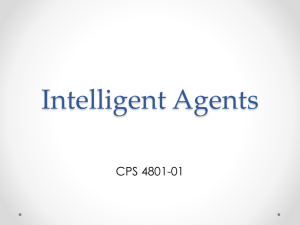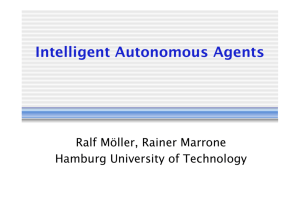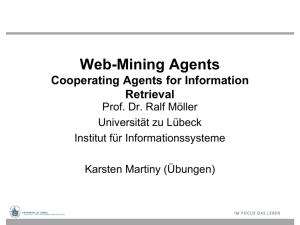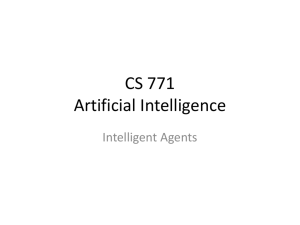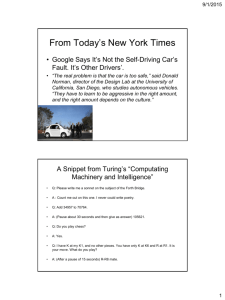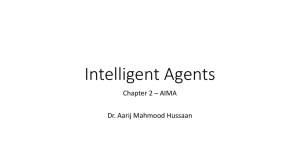AI_Lecture_2
advertisement
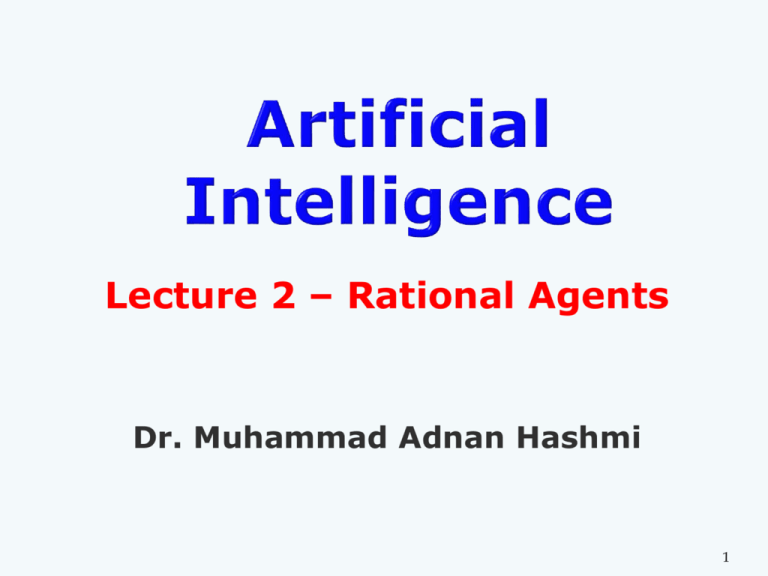
Lecture 2 – Rational Agents Dr. Muhammad Adnan Hashmi 1 Agents and Environments Rationality PEAS (Performance Measure, Environment, Actuators, Sensors) Environment Types Agent types An agent is anything that can be viewed as perceiving its environment through sensors and acting upon that environment through actuators Human agent: Eyes, ears, and other organs for sensors Hands, legs, mouth, and other body parts for actuators Robotic agent: Cameras and infrared range finders for sensors Various motors for actuators. The agent function maps from percept histories to actions: [f: P* A] The agent program runs on the physical architecture to produce f Agent = architecture + program Percepts: location and contents, e.g., [A,Dirty] Actions: Left, Right, Pick_Dirt, NoOp An agent should strive to "do the right thing", based on what it can perceive and the actions it can perform The right action is the one that will cause the agent to be most successful Performance measure: An objective criterion for success of an agent's behavior E.g., performance measure of a vacuumcleaner agent could be amount of dirt cleaned up, amount of time taken, amount of electricity consumed, amount of noise generated, etc. Rational Agent: For each possible percept sequence, a rational agent should select an action that is expected to maximize its performance measure, given the evidence provided by the percept sequence and whatever built-in knowledge the agent has We can also use the term “optimizing the performance measure”. Rationality is distinct from omniscience (allknowing with infinite knowledge) The Agent doesn’t know the actual outcome of its actions Agents can perform actions in order to modify future percepts so as to obtain useful information (information gathering, exploration) An agent is autonomous if its behavior is determined by its own experience (with ability to learn and adapt). PEAS: Performance measure, Environment, Actuators, Sensors Must first specify the setting for intelligent agent design Consider, e.g., the task of designing an automated taxi driver: Performance measure: Safe, fast, legal, comfortable trip, maximize profits Environment: Roads, other traffic, pedestrians, customers Actuators: Steering wheel, accelerator, brake, signal, horn Sensors: Cameras, sonar, speedometer, GPS, odometer, engine sensors, keyboard. Agent: Medical Diagnosis System Performance measure: Healthy patient, minimize costs, lawsuits Environment: Patient, hospital, staff Actuators: Screen display (questions, tests, diagnoses, treatments, referrals) Sensors: Keyboard (entry of symptoms, findings, patient's answers). Agent: Part-picking robot Performance measure: Percentage of parts in correct bins Environment: Conveyor belt with parts, bins Actuators: Jointed arm and hand Sensors: Camera, joint angle sensors. Agent: Interactive English tutor Performance measure: Maximize student's score on test Environment: Set of students Actuators: Screen display (exercises, suggestions, corrections) Sensors: Keyboard. Fully Observable (vs. Partially Observable): An agent's sensors give it access to the complete state of the environment at each point in time In FO, the agent can be confident that it requires nothing more in order to decide on the optimal action PO can be due to faulty sensors If we are driving along a stretch of road that we know well, and if dust enters our eyes, we are still able to drive on the route with blinking eyes (partial observation) PO requires the agent to have an internal representation of the state. Deterministic (vs. Stochastic): The next state of the environment is completely determined by the current state and the action executed by the agent Stochastic (Non-Deterministic): There can be more than one next state, for a given stateaction combination Taxi Driving is clearly stochastic Consider a Multi-agent environment If the environment is deterministic except for the actions of other agents, then the environment is strategic Strategy Games. 14 Episodic (vs. sequential): The agent's experience is divided into atomic "episodes” Each episode consists of the agent perceiving and then performing a single action, and the choice of action in each episode depends only on the episode itself, e.g., a robot whose job is to detect faulty parts on a line in some factory In a sequential setting, the next episode depends on the previous one(s), e.g., learning which chess move to execute at each sequential step, in order to win the game at the end Also called a sequential decision process. 15 Static (vs. Dynamic): The environment is unchanged while an agent is deliberating which action to execute Much more simpler to deal with For the dynamic case, the agent needs to keep track of the changes The environment is semi-dynamic if the environment itself does not change with the passage of time but the agent's performance score does, e.g., checkers. Discrete (vs. Continuous): The environment is discrete if the number of actions and possible states of the environment is finite otherwise it is continuous. Single Agent (vs. Multi-Agent): An agent operating by itself in an environment In the multi-agent case, the performance measure of one agent depends on the performance measures of the other agent(s) Competitive multi-agent: Chess Playing Collaborative multi-agent: Robo Soccer. A quite complicated field which is currently the focus of much research. 17 Fully observable Deterministic Episodic Static Discrete Single agent Chess with a clock Yes Strategic No Semi Yes No Chess without a clock Yes Strategic No Yes Yes No Taxi driving No No No No No No The environment type largely determines the agent design The real world is (of course) partially observable, stochastic, sequential, dynamic, continuous, multiagent. An agent is completely specified by the agent function that maps percept sequences to actions Can also be labeled as the strategy of the agent There could be many possible agent functions Aim: Discover the most rational (optimal) agent function. Simplest possible agent function: All possible states and their optimal actions specified by the designers in advance Drawbacks: Huge table (consider continuous states) Could take a long time to build the table No autonomy! Even with learning, agent could need a long time to learn the table entries. Four basic types in order of increasing generality: Simple Reflex agents Model-based Reflex agents Goal-based agents Utility-based agents And Finally: Learning agents Applies conditionaction rules based only on the current input (reflex) Automated Taxi: Agent observes rain falling on the windshield: Agent powers on the viper Agent observes a red signal; Agent breaks the taxi until it stops. Handles Partial Observability by creating a model Robo-Soccer Example: Imagine a robotic goalkeeper It can build a model of the dynamics of the game that is played on the field, e.g., when the ball is kicked in its direction, the ball will be nearer to it in the next time step If this robot is not able to acquire its state at some time step, then using the model, it knows that the ball has come nearer It also know what consequences a dive will have So, it can time its dive early and hence, save the goal. Along with the model, you need goals to direct the agent function. Automated Taxi: Consider the agent at a crossing, where it can turn right, left, or go straight Using the model, the Agent can understand the consequences of turning left, right or going straight ahead All 3 might seem the optimal actions to take However, the agent needs to select one of these actions in order to reach the destination of the passenger. 27 Solves the problem of conflicting goals, and quantifies the acquirement of goal Automated Taxi: Consider the agent at a crossing, where it can turn right, left, or go straight The agent will calculate the utility of each such action It will select the action which maximizes the utility function, i.e., in most cases, the expected profit that the agent can expect to receive in the long run (when the passenger reaches the destination) E.g., going straight could have highest utility. 29 Feedback Agent Program Random Action Selector Agent Function 31


